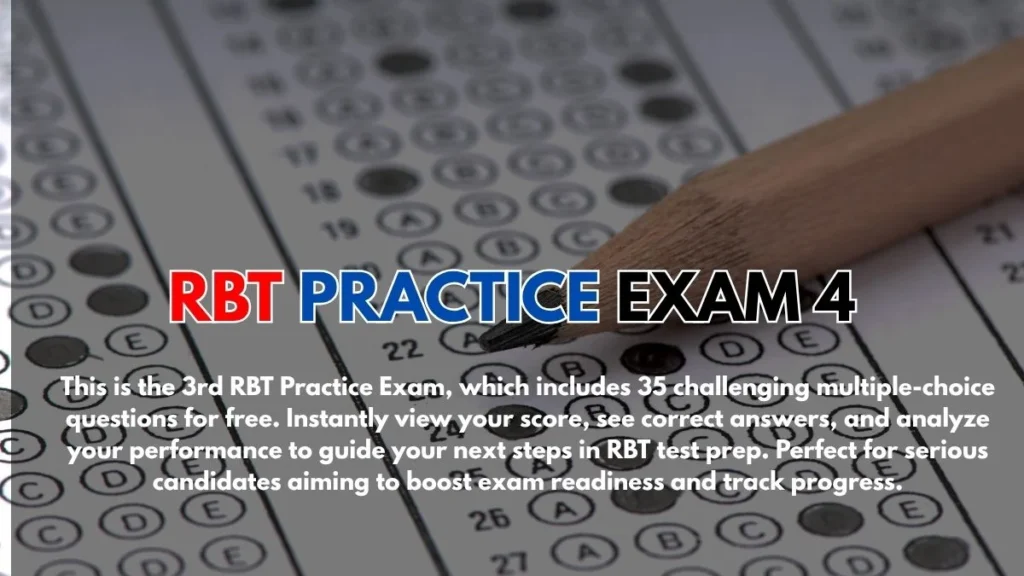RBT Practice Exam 4

Get Ready for RBT Practice Exam 4 has 45 tough questions to test your skills. If you pass all the previous exams from 1 to 3 then this test is for and make sure you keep pushing yourself, you make your mind more tough and your prep more strong. Exam 4 is not just test of skill, but test of will.
Build Calm Mind With Each Try
One big part of the RBT test is not just what you know, but how calm you stay when the time ticks. Stress can make you lose your mind, even if you know the best pick. Many new RBT prep do not see how much calm helps. This free exam is set to train your mind to stay cool when it gets hard. With each ask you face here, you learn to take a deep breath, read slow, and pick smart. Calm is not a gift you are born with, it is a tool you build. The more you train in this way, the more sure you feel when you sit for the real test.
Spot Gaps You Did Not Know
When you first start preparation, you may think you know your weak side. But most times, you are not even aware of all the gaps. Some gaps hide in plain sight. You may have read that part in a book, but never put it to test. This exam helps you catch those blind gaps. Each slip shows a weak spot. Once you see it, you can fix it fast. Think of it like a scan that shows what the eye can not see. That scan helps cure in time. In same way, exam 4 scans your prep so you can see what still needs work.
Why Stage 4 Is Key To Win
Many say that once you reach stage 4, you are close to done. But in truth, stage 4 is the bridge. You have laid base in exam 1, 2, and 3. Now exam 4 is the tie that locks all that work. It is like the last lap in a race. You may be tired, but the end line is in view. If you give up now, all past work drops. If you push on, you seal your win. That is why stage 4 is so key and it shows if you are set for the real RBT or if you still need one more lap of prep.
Train Your Mind For Time
One more thing most do not note is time. In RBT, the clock runs fast and you have only 90 minutes. You do not just need to know facts, you need to act quick. This free exam helps you train with time. Each ask comes with a pace that feels close to the real test. You will learn how to not rush but also not drag.
Wrap Up
Free RBT Practice Exam 4 is not just a set of asks. It is the stage that shows your grit, calm, and skill all in one. You will catch blind gaps, fix weak parts, and build a mind that can face heat of the real test.
| Pos. | Name | Score | Duration | Points | Country |
|---|---|---|---|---|---|
| 1 | Jake N | 96 % | 2 hours 9 minutes 56 seconds | 43 / 45 | |
| 2 | Esther Becerra | 93 % | 9 minutes 2 seconds | 42 / 45 | |
| 3 | Nancy LaFavor | 93 % | 14 minutes 1 seconds | 42 / 45 | |
| 4 | Frank | 89 % | 16 minutes 47 seconds | 40 / 45 | |
| 5 | jjj | 87 % | 24 minutes 1 seconds | 39 / 45 | |
| 6 | kelly | 84 % | 26 minutes | 38 / 45 | |
| 7 | V | 82 % | 14 minutes 24 seconds | 37 / 45 | |
| 8 | Frankieraye94@gmail.com | 80 % | 14 minutes 22 seconds | 36 / 45 | |
| 9 | Safwat Hassan | 78 % | 29 minutes 45 seconds | 35 / 45 | |
| 10 | kk@GMAIL.COM | 78 % | 31 minutes 55 seconds | 35 / 45 | |
| 11 | melva | 73 % | 23 minutes 30 seconds | 33 / 45 | |
| 12 | Maria | 69 % | 3 hours 34 minutes 28 seconds | 31 / 45 | |
| 13 | jenny | 69 % | 16 hours 38 minutes 59 seconds | 31 / 45 | |
| 14 | Socciksit@aol.com | 67 % | 19 minutes 28 seconds | 30 / 45 | |
| 15 | Mirandabyrne2001@gmail.com | 64 % | 17 minutes 2 seconds | 29 / 45 | |
| 16 | victoria | 62 % | 2 hours 4 minutes | 28 / 45 | |
| 17 | hhhh | 51 % | 45 minutes 56 seconds | 23 / 45 | |
| 18 | Kaeleigh | 47 % | 17 minutes 31 seconds | 21 / 45 |
